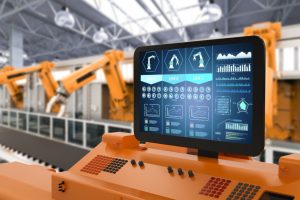Top 8 Types of Industrial Touch Screens Available in 2023 (Part 1)
From the sleek glass surfaces of capacitive screens to the pressure-sensitive technology of force-sensing displays, the world of touchscreen technology is vast and dynamic.
This article navigates through the top eight types of industrial touch screens being used today. Here, we shed light on what they are, how they work, their characteristics, and their applications in today’s tech-savvy era.
What’s a Touch Screen?
A touch screen is a user interface technology that allows individuals to interact with electronic devices by physically touching the screen. It typically involves a transparent panel made of glass or durable plastic which acts like a clear window.
Inside this window, there’s a special layer—often made of a material that conducts electricity—that can detect when and where it’s touched. When you touch the screen, it forms a connection, and the device understands where you touched it. It enables users to input commands, navigate menus, and interact with applications on the device.
Types of Industrial Touch Screens
Touch screens aren’t a recent invention. Throughout the years, numerous types of touchscreen displays and monitors have emerged, propelling them into widespread popularity. They come in diverse configurations, each designed for specific purposes and tailored to suit particular circumstances. Here are eight of the most commonly used:
1. Surface Capacitive Touch Screen
A Surface Capacitive Touch Screen is a type of touch-sensitive display technology that relies on the electrical properties of the human body to detect touch.
The screen of the surface capacitive touch screen is often made of a glass panel coated with a transparent conductive material, usually indium tin oxide (ITO). There are electrodes placed along the edges of the screen that create a low-voltage, continuous electrical field across the screen’s surface.
When you touch the screen with your finger or another conductive object, it disrupts the electrostatic field. This change is detected by the electrodes at the touch point and the controller, then, calculates the coordinates of the touch point based on the disruptions in the electrical field. This information is sent to the device, and the corresponding action is executed.
Surface Capacitive Touch Screens offer several advantages including high clarity, durability, and the ability to support multi-touch functionality. This is why they are often used in medical-grade monitors, public information kiosks, Human-Machine Interface (HMI) systems, and other devices.
2. In-Cell and On-Cell Touch Screen
In-Cell and On-Cell are terms used to describe touchscreen technologies that refer to the integration of touch functionality directly into the display structure, eliminating the need for a separate touch-sensitive layer.
For example, in In-Cell touch screen technology, the touch sensors are integrated into the same layer as the display’s pixels. This integration occurs during the manufacturing of the display itself. The result is a thinner display assembly and improved image quality because there are no additional layers that may affect clarity.
In On-Cell touch screens, the touch sensors are placed on the top surface of the display, but they are still integrated into the display structure. Unlike In-Cell, the touch sensors in On-Cell are not part of the display’s pixel layer.
Both In-Cell and On-Cell technologies aim to enhance display performance and user experience by reducing the device’s overall thickness and potentially improving display performance.
The choice between these technologies often depends on factors such as the device’s design requirements, cost considerations, and the desired balance between thinness and display quality.
In-Cell and On-Cell touch screens are often used in devices across different industries such as automotive displays, diagnostic equipment, industrial control panels, etc. because they also offer more streamlined manufacturing processes.

3. Force-Sensing Touch Screen
Also known as pressure-sensitive touch screens, Force-Sensing touch screens are a type of touch-sensitive display technology that responds not only to the presence of touch but also to the amount of force applied to the screen.
Unlike traditional touch screens that register touch based on contact or proximity, force-sensing touch screens can measure the level of pressure exerted at the touch point.
How does it work? The touch screen contains sensors that can detect the amount of pressure or force applied to the screen. These sensors can be strategically placed across the screen’s surface. But instead of providing a binary response (touched or not touched), force-sensing touch screens provide analog input. This means they can register a range of pressure levels, allowing for more nuanced interactions.
It allows the device to interpret the force and trigger different actions/responses based on the degree of pressure. For example, a lighter touch might result in one action, while a firmer touch could trigger a different response.
Force-sensing touch screens are used in applications where variable input and pressure sensitivity are beneficial such as:
- Digital art tablets;
- Certain types of stylus input devices;
- Medical tablets;
- Diagnostic equipment;
- Digital charting;
- Diagnostic tools;
- In-car touchscreens and control panels;
- Interactive displays; and
- Smart whiteboards
4. Gesture-Based Touch Screen
Gesture-based touch screen recognizes and responds to specific hand or finger movements known as gestures. Thus, the name.
Unlike other touch screens that rely solely on taps, gesture-based industrial touch screens can interpret more complex motions such as swipes, pinches, rotations, and multi-finger taps to trigger specific actions or commands.
Many gesture-based touch screens support multi-touch functionality, enabling the recognition of multiple gestures or touches simultaneously. This allows for more complex and dynamic interactions such as zooming, rotating, and manipulating on-screen objects.
Gesture-based touch screens are often found in various industries such as gaming, healthcare, education, and retail because they provide users with a more intuitive and immersive way to control and navigate digital interfaces.
In healthcare, for example, surgeons may use gesture-based interfaces during surgeries, making the procedure easier. Gesture-based touch screen technology may utilize advanced sensing technologies such as cameras, infrared sensors, or 3D depth sensing to accurately capture and interpret gestures. These technologies enable precise recognition of hand movements and gestures in three-dimensional space.
IVS-Tech: Your Provider of Quality Industrial Touch Screens
Industrial touchscreens enhance the user experience, streamline operations, and provide a more intuitive interface for users in different industries.
So if you’re on the lookout for high-quality industrial touchscreens, look no further than IVS-Tech. We’ve been providing customized solutions, better price-to-performance, and a stable supply of industrial touch screens to clients all over the world.
Contact us today for a personalized consultation or if you want to know more about products.






